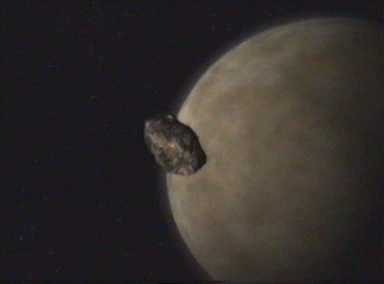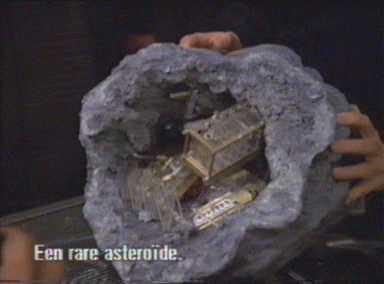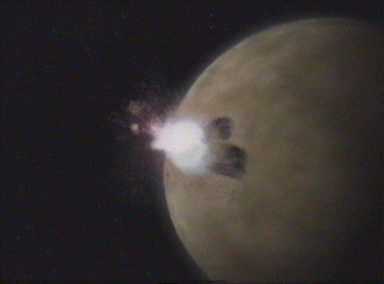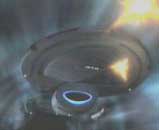The Asteroid Destruction Scene in "Rise"[VOY]
 |
| [Editor's note: in this page, RSA claims the asteroid
above is 400 metres long (from the little orange dot, which is a photorp that's
supposedly 10 metres wide because he figures the "glow" is
that big |
Anderson's page on the asteroid destruction scene in "Rise" [VOY], is one of the strongest technical pages on his website, however it is fundamentally flawed. A debate about this very subject was brought up on StarDestroyer.net some time ago (click here to see it). The argument presented by one poster was addressed weakly by Anderson's site, and will be repeated here.

"If Chakotay was able to crack a beachball sized hunk of the thing open with a pick, how is it possible that Voyager did so little damage to it if Voyager's weapons were anywhere near what DarkStar is claiming? Note that the crack through the asteroid is evidently not the result of repeated chiselling, or any kind of cutting laser (or similar). If it was a cutting laser, we would have expected the asteroid's edges to be smooth, with a single cut going straight through the rock. If it was from repeated chiselling, we would see evidence of that (tool marks, rock shavings, etc.). Instead we see evidence of a fairly clean fracture, like the ones that most kids would get from cracking open a golf ball sized geode with a hammer. It was likely the result of only a few, strong blows, if that. This represents an EXTRAORDINARILY low strength for the rock.
So how can Voyager have done so little damage to rock that was that fragile if it had the firepower that DarkStar was claiming? The answer is, of course, that it is impossible. Voyager's torpedoes are likely reasonably powerful, but this incident shows a pathetically weak firepower for what is probably Voyager's most powerful weapon. DarkStar, in this case, was mistaken.
Not that I find that surprising."
Anderson has since responded to the above criticism of his website in his "Objections" section:
"1. If Chakotay was able to tap a piece of the asteroid open with a little pick-axe, the asteroid must have been brittle. If it was made of such brittle materials, Voyager's torpedo should have done more damage.
There's a profound difference between taking a sharp pick against a solid rock and vaporizing it with a photon torpedo explosion. First, a rock has characteristics such as cleavage and fracture. That is, in fact, one of the ways rocks are identified.
Torres identifies olivine as one of the substances in the rock. You'll note that olivine has a brittle, conchoidal (shell-like) fracture. In other words, it breaks easily into curved fragments, not unlike glass does. Also pay attention to the fact that it is rather hard, but with a low density. Something hard, low density, and brittle is going to be easy to crack.
Compare this with iron, which they thought the asteroid was made of. It's softer, and thus more malleable. It has a higher density, and a jagged, torn fracture. Now, let's say you fire a bullet at a wall made of olivine. You'll probably end up with a hunk of broken fragments flying away, and might even get cracks running from the point of impact. Do the same to an iron wall, and if the bullet penetrates more than a dent's worth, you'll get torn metal.
Detonate a thermonuclear weapon next to that wall, and the olivine wall will probably shatter. The more resilient iron wall may either tear wide open, or just sit there and melt, et cetera, depending on various factors.
This would assume, of course, that the entire asteroid was olivine, and not nickel-iron with a couple of oddball chunks of olivine. Given the fact that it fragmented in the way it did without vaporizing as expected, that isn't a bad hypothesis. But, then, the Nisu astrophysicist dude mentioned in his transmission that the asteroids were composed of artificial materials . . . whether he had simply found evidence that triatium alloy was part of the asteroid, or had found that sensor signals were being distorted, or found that the majority of the asteroids were literally artificial is not clear.
In any event, the brittleness of a material is no indication that it will be easier to vaporize . . . indeed, it is far more likely to fracture uncontrollably, and in this case unexpectedly."
What Anderson said was accurate. One would expect a rock, like olivine, to fracture and break more easily than iron or nickel (or, iron and nickel), both of which are softer metals. However, Harry Kim expected that the asteroid (which he, at the time, presumed was made up of iron-nickel) to fracture and break apart. So, if olivine breaks more easily than iron-nickel, and iron-nickel is what he was expecting to fragment, how can the torpedo have demonstrated as much firepower as Anderon is claiming with this page? The simple answer is that it could not have. If the weapon were as powerful as Kim and Chakotay expected it to be, and the asteroid was as brittle as it was demonstrated later as being, then the asteroid should have been completely shattered. This is clearly not what was observed when the torpedo destroyed the asteroid.
Additionally, Anderson's scaling work is highly suspect.
[Editor's note: As noted, it is ridiculous to contradict the observation of brittleness by saying it's made of a brittle silicate like olivine; this actually concedes the point! But sadly, this is merely the beginning of the problems with this page. It gets worse, and while one might normally chalk such errors up to ignorance, in RSA's case they are undoubtedly the result of deliberate deceit:
First, let's review asteroids types, using information taken from Purdue University's relevant page on the subject. There are three types of asteroids: C-type (carbonaceous, low-density, made of low atomic-number elements, dark in appearance), S-type (silicaceous, medium-density, made of iron and iron silicates such as olivine, bright in appearance), and M-type (metallic, high-density, made mostly of metallic iron, bright in appearance). Metallic asteroids are the most difficult to fragment (it takes thirty times more energy to fragment iron than granite) because of their great strength and high density Now, let's see how RSA goes about classifying a brittle, dark asteroid as M-type:
"The extremely dark and mottled coloring of the asteroid is a bit odd, but not unreasonably so. From what we know of the asteroid, it should fall within the parameters of an M-type . . . S-type if the olivine was common throughout ..." Think about this; it doesn't look like an M-type asteroid, and it's much too brittle to be an M-type asteroid, but we "know" it's an M-type asteroid anyway? Then he dismisses the appearance of a C-type asteroid by saying that if it's olivine, it must be an S-type! Think about this logic for a minute: he knows it's brittle, and olivine is brittle, so it must be olivine, so it must be an S-type asteroid instead of a C-type asteroid even though it looks like one ... so he can use M-type asteroid material properties. Are you dizzy yet?
"If we assume that the asteroid started out at 200 Kelvin, and that it would therefore take 7.6 megajoules to vaporize one kilogram of iron, we are still left with a necessary energy figure of 184,790,301,840 megajoules. That's 184,790 TJ, or 44 megatons, as an absolute I-bent-over-backward lower limit." Interesting, isn't it? The asteroid is clearly fragmented, not vapourized, as we can see in the pictures. He even says "I am leaving plenty of room for Harry's comment that "we shouldn't be seeing fragments more than a centimeter in diameter"". But then he goes ahead and uses vapourization figures, not fragmentation figures, and he has the gall to call this an "absolute I-bent-over-backward lower limit"! He even goes so far as to repeatedly use Kim's "expectation" of vapourization as evidence! Normally, one's opponent in a debate may try to be deceptive, but he'll stop short of outright lies. RSA, however, crosses that line.
"100 megatons (420,000 terajoules) would appear to be an extreme but fair low-end figure" Actually, given the fact that the asteroid was fragmented, not vapourized, and was observed to be brittle, the energy requirement for shattering a 400 metre wide asteroid (even if we accept his bizarre scaling) is only 10-15 kilotons (see calculator, using hard granite figures for cratering). Even if we assume nickel-iron despite its dark appearance and brittle nature, we're still looking at just 300 kilotons. He can claim that it's vapourized, but the screenshots say otherwise:

"Certainly their own high-end estimates (250 TJ, 1500 TJ, and 701 to 2863 TJ) of the highest turbolaser firepower seen in the canon don't come anywhere close to even 100 megatons" This is another fine example of his pathological-liar tendencies: he takes the tiny-asteroid lower-limit from TESB and says we call it a "high-end estimate" even though we actually call it an extreme lower limit (and let's not even talk about Jango Fett pulverizing asteroids in a multi-kilometre radius in AOTC).
"the pic below demonstrates the size increase of torpedoes fired from Voyager":

Yes, that's right. He claims that photon torpedoes get bigger after they're launched, and uses this enlarged size to scale the asteroid. Of course, the fact that the torpedoes are approaching the camera and thus obvious getting bigger due to perspective correction is undoubtedly lost on him ...
It is quite sad that this is one of the strongest technical pages on RSA's site, because it is disturbingly bad and reveals a startling level of incompetence. Usually (as with someone like Lord Edam), you need to look up factoids in order to disprove his claims. He may be legitimately misinterpreting facts or working from ignorance, rather than lying. But with RSA, you can simply look through his work and see where he has repeatedly contradicted himself, sometimes in the same paragraph(!), and used obvious logical fallacies (ironic for someone who throws the word "fallacy" around as if it's going out of style)].